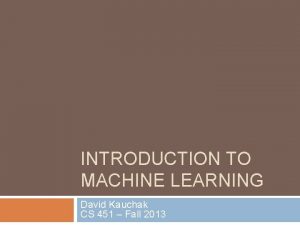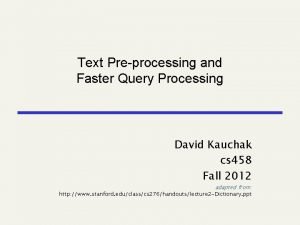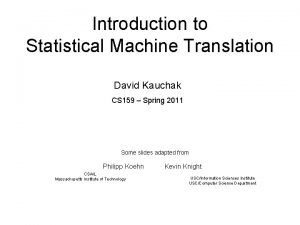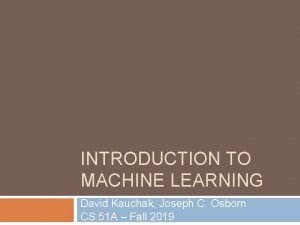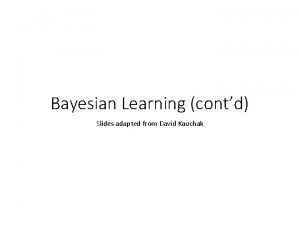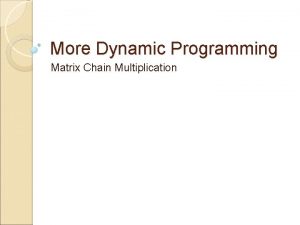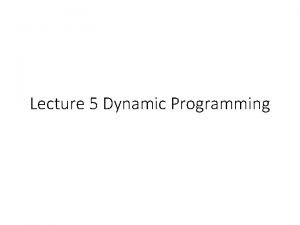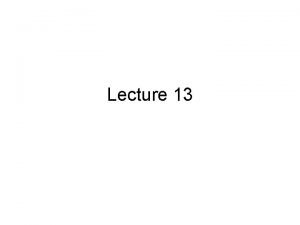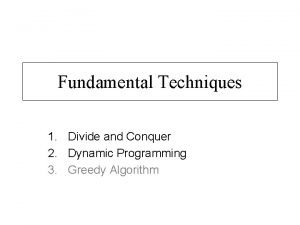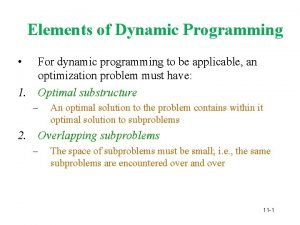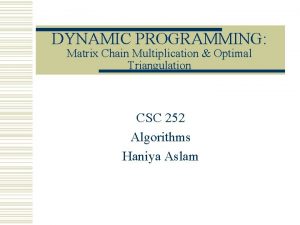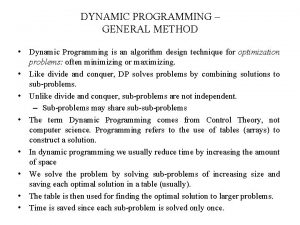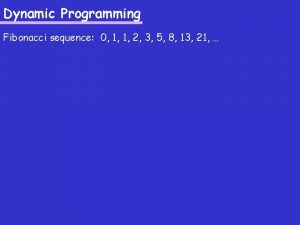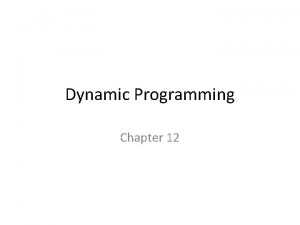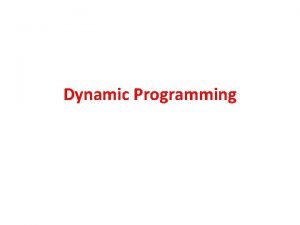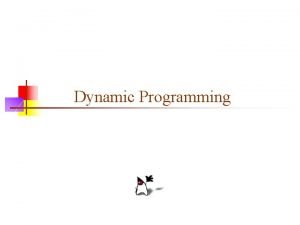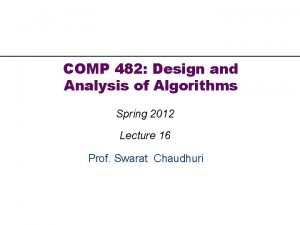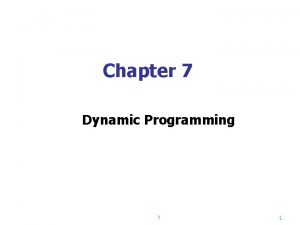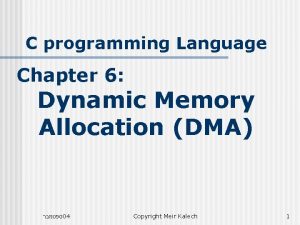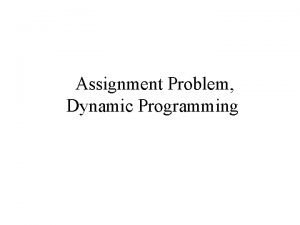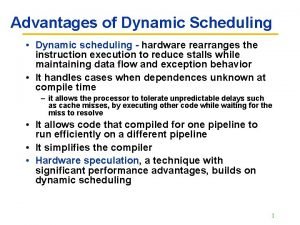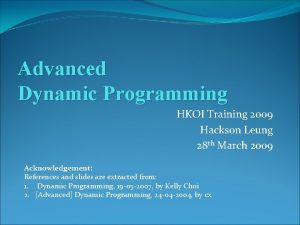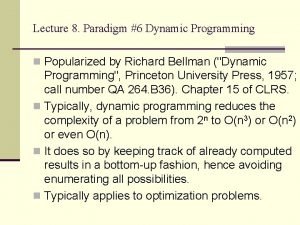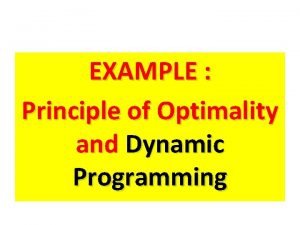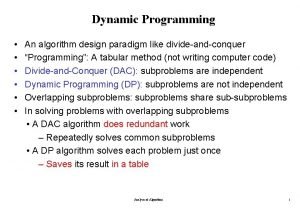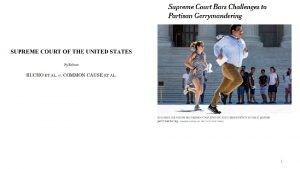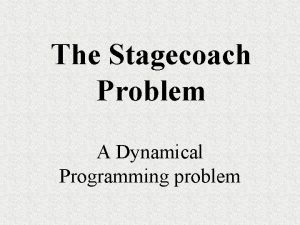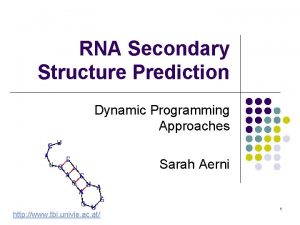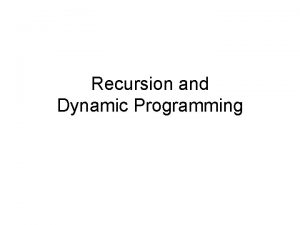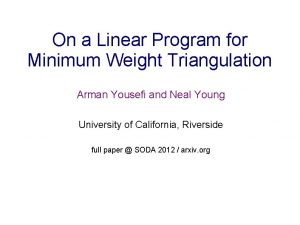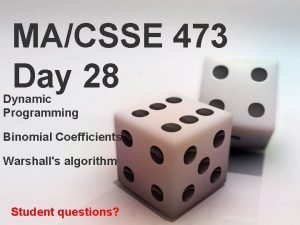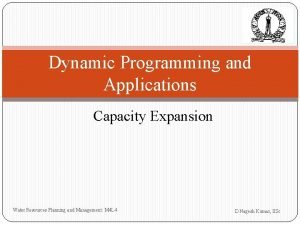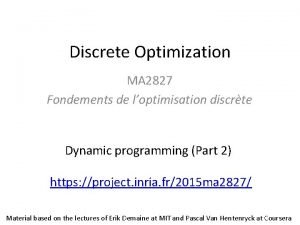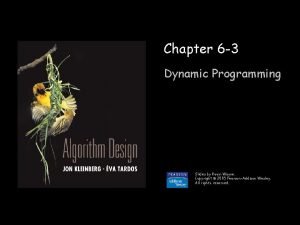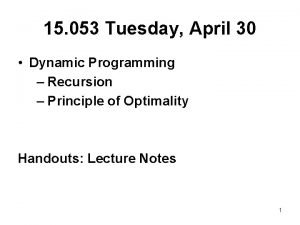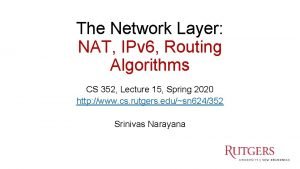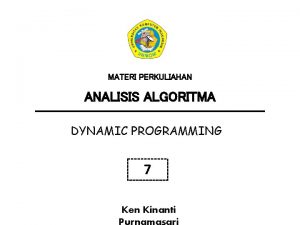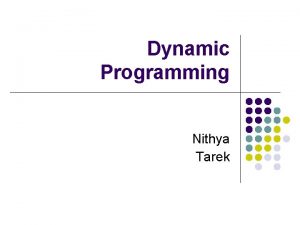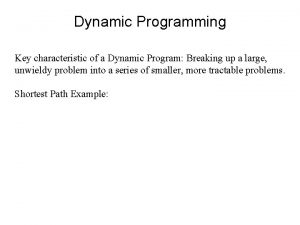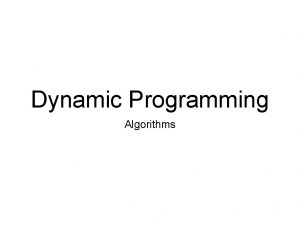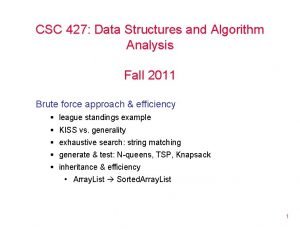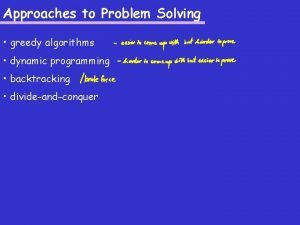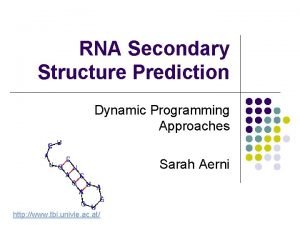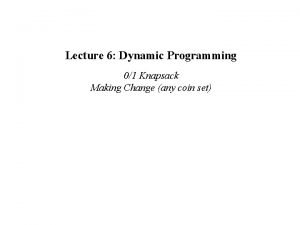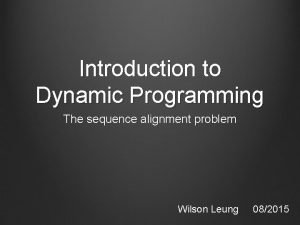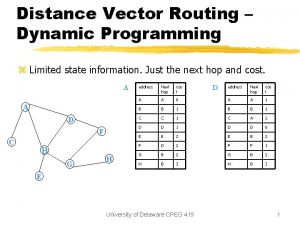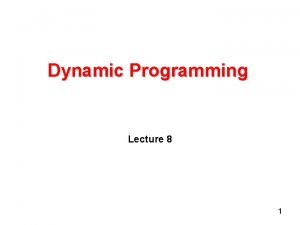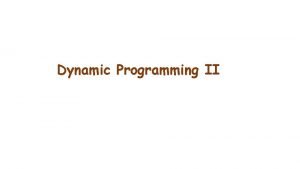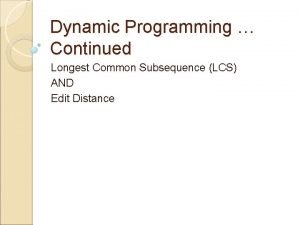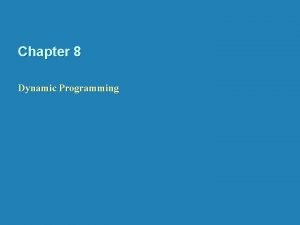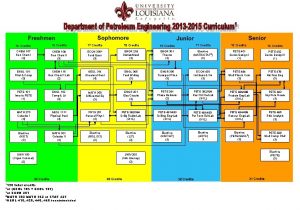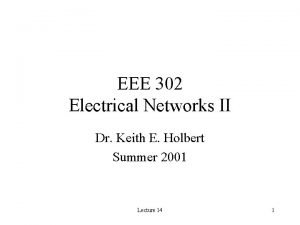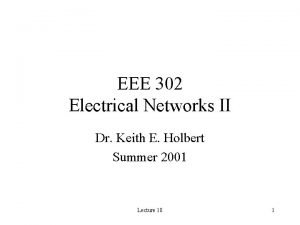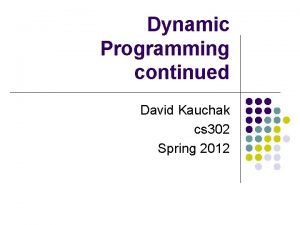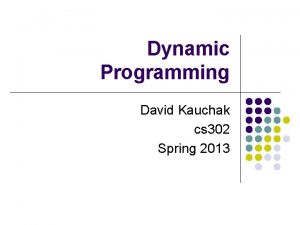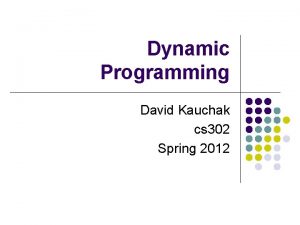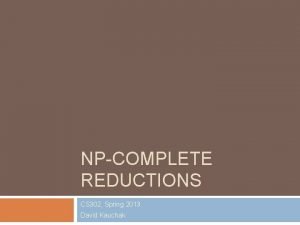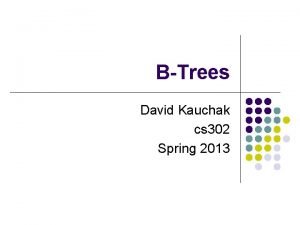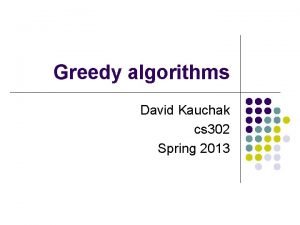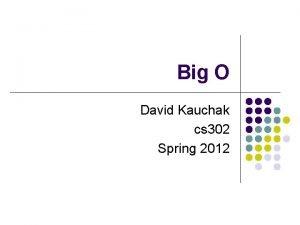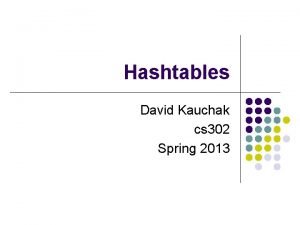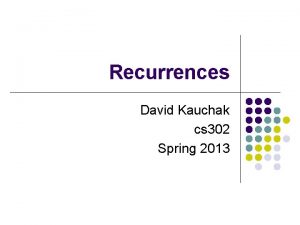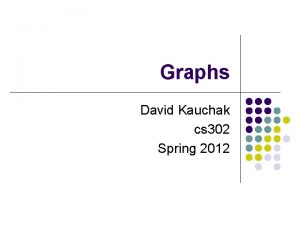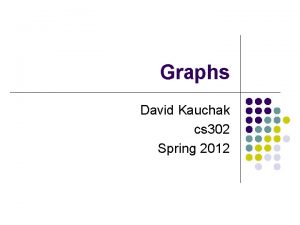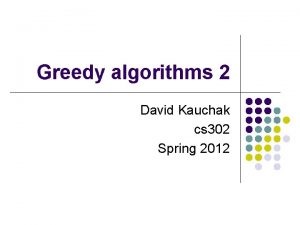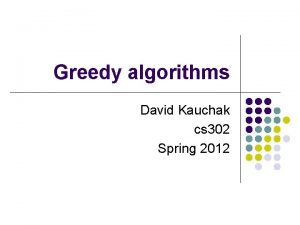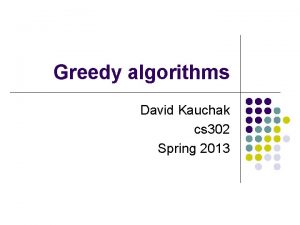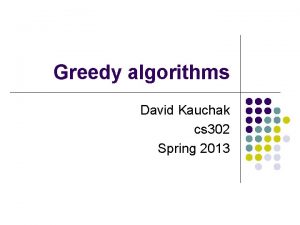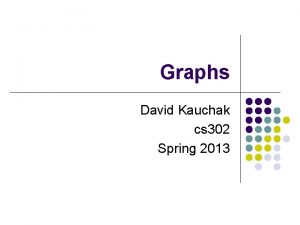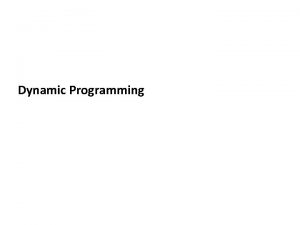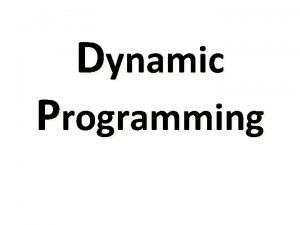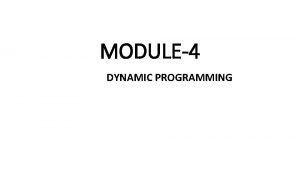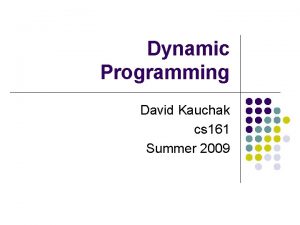Dynamic Programming continued David Kauchak cs 302 Spring










































































- Slides: 74

Dynamic Programming continued David Kauchak cs 302 Spring 2013

Admin l l No office hours tomorrow Assignments 14 AND 15 will be made available today l assignment 15 will be programming a DP algorithm, so look at this sooner than later

Where did “dynamic programming” come from? Richard Bellman On the Birth of Dynamic Programming Stuart Dreyfus http: //www. eng. tau. ac. il/~ami/cd/o r 50/1526 -5463 -2002 -50 -010048. pdf

Longest increasing subsequence Given a sequence of numbers X = x 1, x 2, …, xn find the longest increasing subsequence (i 1, i 2, …, ik), that is a subsequence where numbers in the sequence increase. 5 2 8 6 3 6 9 7

Longest increasing subsequence Given a sequence of numbers X = x 1, x 2, …, xn find the longest increasing subsequence (i 1, i 2, …, ik), that is a subsequence where numbers in the sequence increase. 5 2 8 6 3 6 9 7

Step 1: Define the problem with respect to subproblems 5 2 8 6 3 6 9 7 Two options: Either 5 is in the LIS or it’s not

Step 1: Define the problem with respect to subproblems 5 2 8 6 3 6 9 7 include 5 5 + LIS(8 6 3 6 9 7)

Step 1: Define the problem with respect to subproblems 5 2 8 6 3 6 9 7 include 5 5 + LIS(8 6 3 6 9 7) What is this function exactly? longest increasing sequence of the numbers starting with 8

Step 1: Define the problem with respect to subproblems 5 2 8 6 3 6 9 7 include 5 5 + LIS(8 6 3 6 9 7) What is this function exactly? longest increasing sequence of the numbers This would allow for the option of sequences starting with 3 which are NOT valid!

Step 1: Define the problem with respect to subproblems 5 2 8 6 3 6 9 7 include 5 5 + LIS’(8 6 3 6 9 7) longest increasing sequence of the numbers starting with 8 Do we need to consider anything else for subsequences starting at 5?

Step 1: Define the problem with respect to subproblems 5 2 8 6 3 6 9 7 include 5 5 + LIS’(8 6 3 6 9 7) 5 + LIS’(6 9 7) 5 + LIS’(7)

Step 1: Define the problem with respect to subproblems 5 2 8 6 3 6 9 7 don’t include 5 LIS(2 8 6 3 6 9 7) Anything else? Technically, this is fine, but now we have LIS and LIS’ to worry about. Can we rewrite LIS in terms of LIS’?

Step 1: Define the problem with respect to subproblems Longest increasing sequence for X is the longest increasing sequence starting at any element And what is LIS’ defined as (recursively)?

Step 1: Define the problem with respect to subproblems Longest increasing sequence for X is the longest increasing sequence starting at any element Longest increasing sequence starting at i

Step 2: build the solution from the bottom up LIS’: 5 2 8 6 3 6 9 7

Step 2: build the solution from the bottom up LIS’: 1 5 2 8 6 3 6 9 7

Step 2: build the solution from the bottom up LIS’: 1 5 2 8 6 3 6 9 7

Step 2: build the solution from the bottom up LIS’: 1 1 5 2 8 6 3 6 9 7

Step 2: build the solution from the bottom up LIS’: 1 1 5 2 8 6 3 6 9 7

Step 2: build the solution from the bottom up LIS’: 2 1 1 5 2 8 6 3 6 9 7

Step 2: build the solution from the bottom up LIS’: 3 2 1 1 5 2 8 6 3 6 9 7

Step 2: build the solution from the bottom up LIS’: 2 3 2 1 1 5 2 8 6 3 6 9 7

Step 2: build the solution from the bottom up LIS’: 2 2 3 2 1 1 5 2 8 6 3 6 9 7

Step 2: build the solution from the bottom up LIS’: 4 2 2 3 2 1 1 5 2 8 6 3 6 9 7

Step 2: build the solution from the bottom up LIS’: 3 4 2 2 3 2 1 1 5 2 8 6 3 6 9 7

Step 2: build the solution from the bottom up LIS’: 3 4 2 2 3 2 1 1 5 2 8 6 3 6 9 7

Step 2: build the solution from the bottom up What does my data structure for storing answers look like?

Step 2: build the solution from the bottom up 1 -D array: only one thing changes for recursive calls, i

Step 2: build the solution from the bottom up

Step 2: build the solution from the bottom up start from the end (bottom)

Step 2: build the solution from the bottom up

Step 2: build the solution from the bottom up

Step 2: build the solution from the bottom up initialization?

Running time? Θ(n 2)

Another solution Can we use LCS to solve this problem? 5 2 8 6 3 6 9 7 LCS 2 3 5 6 6 7 8 9

Another solution Can we use LCS to solve this problem? 5 2 8 6 3 6 9 7 LCS 2 3 5 6 6 7 8 9

Memoization Sometimes it can be a challenge to write the function in a bottom-up fashion Memoization: l l Write the recursive function top-down Alter the function to check if we’ve already calculated the value If so, use the pre-calculate value If not, do the recursive call(s)

Memoized fibonacci

Memoized fibonacci

Memoized fibonacci Use to denote uncalculated

Memoized fibonacci What else could we use besides an array? Use to denote uncalculated

Memoized fibonacci Check if we already calculated the value

Memoized fibonacci calculate the value

Memoized fibonacci store the value

Memoization Pros l l Can be more intuitive to code/understand Can be memory savings if you don’t need answers to all subproblems Cons l Depending on implementation, larger overhead because of recursion (though often the functions are tail recursive)

Edit distance (aka Levenshtein distance) Edit distance between two strings is the minimum number of insertions, deletions and substitutions required to transform string s 1 into string s 2 Insertion: ABACED ABACCED Insert ‘C’ DABACCED Insert ‘D’

Edit distance (aka Levenshtein distance) Edit distance between two strings is the minimum number of insertions, deletions and substitutions required to transform string s 1 into string s 2 Deletion: ABACED

Edit distance (aka Levenshtein distance) Edit distance between two strings is the minimum number of insertions, deletions and substitutions required to transform string s 1 into string s 2 Deletion: ABACED Delete ‘A’

Edit distance (aka Levenshtein distance) Edit distance between two strings is the minimum number of insertions, deletions and substitutions required to transform string s 1 into string s 2 Deletion: ABACED Delete ‘A’ BACE Delete ‘D’

Edit distance (aka Levenshtein distance) Edit distance between two strings is the minimum number of insertions, deletions and substitutions required to transform string s 1 into string s 2 Substitution: ABACED ABADED Sub ‘D’ for ‘C’ ABADES Sub ‘S’ for ‘D’

Edit distance examples Edit(Kitten, Mitten) = 1 Operations: Sub ‘M’ for ‘K’ Mitten

Edit distance examples Edit(Happy, Hilly) = 3 Operations: Sub ‘a’ for ‘i’ Hippy Sub ‘l’ for ‘p’ Hilly

Edit distance examples Edit(Banana, Car) = 5 Operations: Delete ‘B’ anana Delete ‘a’ nana Delete ‘n’ naa Sub ‘C’ for ‘n’ Caa Sub ‘a’ for ‘r’ Car

Edit distance examples Edit(Simple, Apple) = 3 Operations: Delete ‘S’ imple Sub ‘A’ for ‘i’ Ample Sub ‘m’ for ‘p’ Apple

Edit distance Why might this be useful?

Is edit distance symmetric? that is, is Edit(s 1, s 2) = Edit(s 2, s 1)? Edit(Simple, Apple) =? Edit(Apple, Simple) Why? l l l sub ‘i’ for ‘j’ → sub ‘j’ for ‘i’ delete ‘i’ → insert ‘i’ → delete ‘i’

Calculating edit distance X=ABCBDAB Y=BDCABA Ideas?

Calculating edit distance X=ABCBDA? Y=BDCAB? After all of the operations, X needs to equal Y

Calculating edit distance X=ABCBDA? Y=BDCAB? Operations: Insert Delete Substitute

Insert X=ABCBDA? Y=BDCAB?

Insert X=ABCBDA? Edit Y=BDCAB?

Delete X=ABCBDA? Y=BDCAB?

Delete X=ABCBDA? Edit Y=BDCAB?

Substition X=ABCBDA? Y=BDCAB?

Substition X=ABCBDA? Edit Y=BDCAB?

Anything else? X=ABCBDA? Y=BDCAB?

Equal X=ABCBDA? Y=BDCAB?

Equal X=ABCBDA? Edit Y=BDCAB?

Combining results Insert: Delete: Substitute: Equal:

Combining results

Running time Θ(nm)

Variants l Only include insertions and deletions l What does this do to substitutions? l Include swaps, i. e. swapping two adjacent characters counts as one edit l Weight insertion, deletion and substitution differently l Weight specific character insertion, deletion and substitutions differently l Length normalize the edit distance

Quick summary l Step 1: Define the problem with respect to subproblems l l l We did this for divide and conquer too. What’s the difference? You can identify a candidate for dynamic programming if there is overlap or repeated work in the subproblems being created Step 2: build the solution from the bottom up l l Build the solution such that the subproblems referenced by larger problems are already solved Memoization is also an alternative

0 -1 Knapsack problem l 0 -1 Knapsack – A thief robbing a store finds n items worth v 1, v 2, . . , vn dollars and weight w 1, w 2, …, wn pounds, where vi and wi are integers. The thief can carry at most W pounds in the knapsack. Which items should the thief take if he/she wants to maximize value? l Repetition is allowed, that is you can take multiple copies of any item
 Cs 451
Cs 451 David kauchak
David kauchak David kauchak
David kauchak David kauchak
David kauchak David kauchak
David kauchak David kauchak
David kauchak David kauchak
David kauchak Greedy vs dynamic
Greedy vs dynamic Introduction to teaching becoming a professional
Introduction to teaching becoming a professional Giduk
Giduk When is spring summer autumn and winter
When is spring summer autumn and winter Spring legacy project 없을때
Spring legacy project 없을때 Transferered
Transferered Tabulation in dynamic programming
Tabulation in dynamic programming Matrix multiplication
Matrix multiplication A b a b c d e
A b a b c d e Parenthesization
Parenthesization Divide and conquer
Divide and conquer Elements of dynamic programming
Elements of dynamic programming Dynamic programming vs divide and conquer
Dynamic programming vs divide and conquer Dynamic programming general method
Dynamic programming general method Dynamic programming in excel
Dynamic programming in excel Fibonacci with dynamic programming
Fibonacci with dynamic programming Egg drop algorithm
Egg drop algorithm Greedy vs divide and conquer
Greedy vs divide and conquer Dynamic programming algorithm
Dynamic programming algorithm Segmented least squares dynamic programming
Segmented least squares dynamic programming Backward approach in multistage graph
Backward approach in multistage graph Dynamic c programming
Dynamic c programming Assignment problem dynamic programming
Assignment problem dynamic programming Advantages of dynamic programming
Advantages of dynamic programming Dynamic programming bottom up
Dynamic programming bottom up Knapsack dynamic programming
Knapsack dynamic programming Dynamic programming paradigm
Dynamic programming paradigm Dynamic problem
Dynamic problem Algorithm design paradigm
Algorithm design paradigm Advantages and disadvantages of dynamic memory allocation
Advantages and disadvantages of dynamic memory allocation Gerrymandering dynamic programming
Gerrymandering dynamic programming Stagecoach problem dynamic programming
Stagecoach problem dynamic programming Rna secondary structure dynamic programming
Rna secondary structure dynamic programming Recursive thinking definition
Recursive thinking definition Minimum weight triangulation
Minimum weight triangulation Binomial coefficient using dynamic programming
Binomial coefficient using dynamic programming Manhattan tourist problem
Manhattan tourist problem Dynamic programming recursion example
Dynamic programming recursion example Discrte
Discrte Dynamic programming slides
Dynamic programming slides Bh&m
Bh&m Dynamic programming equation
Dynamic programming equation Contoh algoritma dynamic programming
Contoh algoritma dynamic programming Dynamic programming
Dynamic programming Characteristics of dynamic programming
Characteristics of dynamic programming Dynamic programming in excel
Dynamic programming in excel Levenshtein distance for oslo-snow
Levenshtein distance for oslo-snow Dynamic programming
Dynamic programming Dynamic programming
Dynamic programming Pseudoknot structure
Pseudoknot structure Dynamic programming
Dynamic programming Binomial coefficient dynamic programming
Binomial coefficient dynamic programming Gap strategy in dynamic programming
Gap strategy in dynamic programming Dynamic programming
Dynamic programming Dynamic programming history
Dynamic programming history Parenthesization
Parenthesization Edit distance dynamic programming
Edit distance dynamic programming Floyd warshall algorithm transitive closure
Floyd warshall algorithm transitive closure Perbedaan linear programming dan integer programming
Perbedaan linear programming dan integer programming Windows 10 system programming, part 1
Windows 10 system programming, part 1 Integer programming vs linear programming
Integer programming vs linear programming Programing adalah
Programing adalah 7285 x 302
7285 x 302 A 302
A 302 Mat 302 bmcc
Mat 302 bmcc What is growth and development
What is growth and development Eee 302
Eee 302 Eee 302
Eee 302
